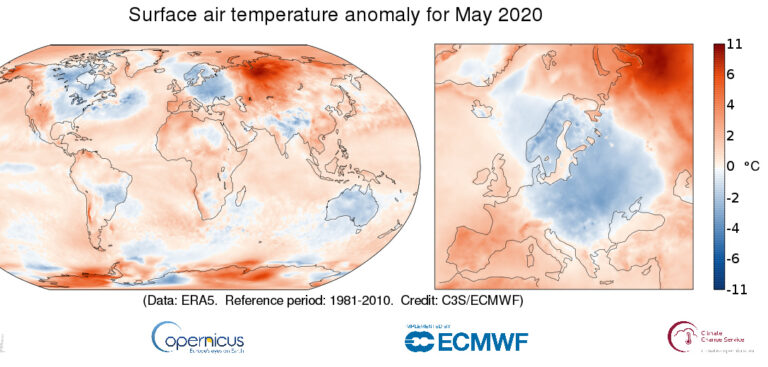Global surface temperatures for the first five months of the year were the second highest on record, marginally behind the strong El Niño year of 2016, reports the WMO. Significantly, last month was the warmest May on record, according to US and European data sets.
NOAA, which reports monthly climatological data from observing sites, said that May global temperatures tied with 2016. It was the 44thth consecutive May and the 425th consecutive month with temperatures above – at least nominally – the 20th century average. The seven warmest Mays have all occurred in the past seven years.
Meanwhile, analysis by NOAA’s National Centers for Environmental Information shows that 2020 is likely (>99.9%) to rank among the five warmest years on record. This analysis was based on current anomalies and historical global annual temperature readings that have confirmed a long-term warming trend due to heat-trapping greenhouse gases in the atmosphere.
The rises follow the trend of 2015-2019 being the warmest five-year period on record and 2010-2019 the warmest decade on record. The WMO notes that since the 1980s, each successive decade has been warmer than any preceding decade since 1850, according to its State of the Global Climate reports.
The northern hemisphere had its warmest May on record, driven by exceptional heat in Siberia where temperatures were up to 10°C (50°F) above average. The unusual warmth in winter and spring was associated with an exceptionally early break-up of ice in Siberia’s rivers and a massive diesel spill, which according to media reports was due to melting permafrost beneath tank supports.
To bring public attention to climate change, broadcast meteorologists around the world staged the third annual Mets Unite Show Your Stripes campaign on the June 18. The warming stripes show global warming in cities and countries around the world, with the concentration of ‘red’ years in the 21st century. That long-term trend is continuing in 2020.
According to the Copernicus Climate Change Service, “Although the planet as a whole is warming, this isn’t happening evenly. For example, western Siberia stands out as a region that is warming faster than average and where variations in temperature from month to month and year to year tend to be large. However, what is unusual in this case is how long the warmer-than-average anomalies have persisted.” However, the service noted that, in contrast to Siberia, much of Alaska saw cooler than average temperatures in May.
The WMO points out that surface temperatures are only one indicator of climate change. Others include ocean heat, ocean acidification, sea level, glaciers, Arctic and Arctic sea ice extent, and atmospheric carbon dioxide, which continues to be at record levels.



